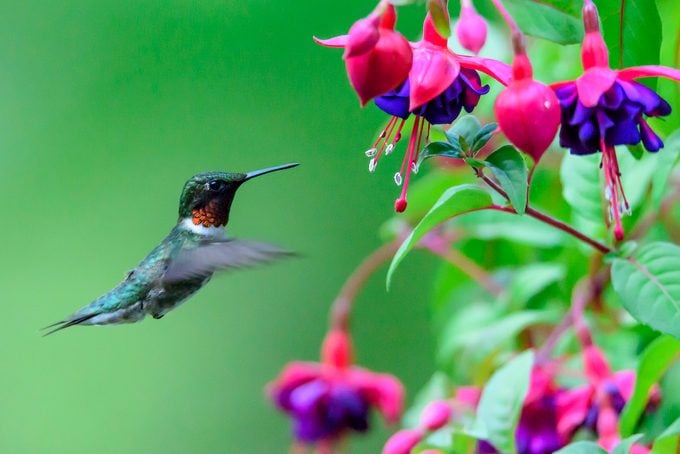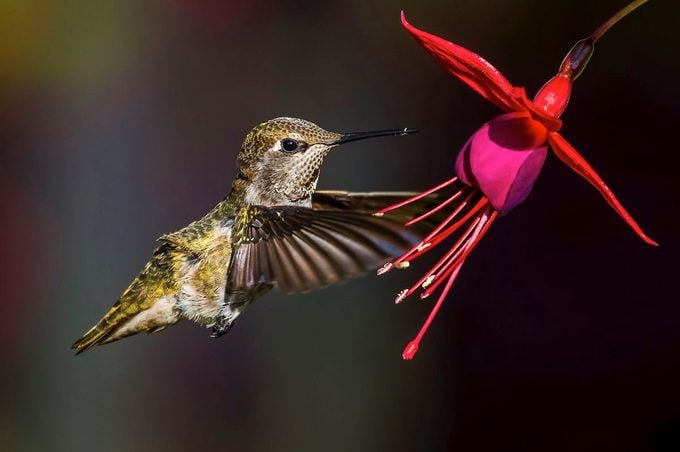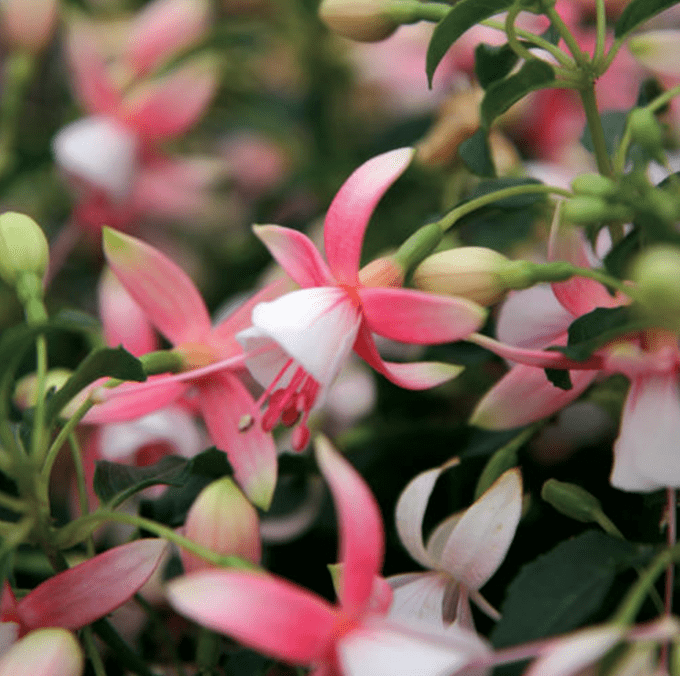Grow a Flowering Fuchsia Plant for Hummingbirds
Updated: Feb. 29, 2024
A fuchsia plant is a beautiful summer bloomer. It makes an excellent container plant and is well-known for attracting hummingbirds.
On This Page
Fuchsia Plant Care and Growing Tips

- Scientific name: Fuchsia spp.
- Common names: Fuchsia, lady’s eardrops, hardy fuchsia, hummingbird fuchsia
- Light needs: Shade to Part Shade
- Hardiness zones: 10 to 11 or annual
- Size: 10 to 24 inches tall
- Benefits: Attracts hummingbirds, birds, butterflies and moths
Fuchsias are summer flowering plants with colorful, pendulous blossoms. Hummingbirds are attracted to the flowers’ bright colors. Their long tongues have adapted to access the high amount of nectar.
Fuchsias are perennial plants in zones 10 and 11, but most are not winter hardy so you can treat them as annuals or overwinter them as houseplants. Many have a trailing habit, perfect for hanging baskets and containers. The upright forms can be trained as standards (tree or lollipop shape) or as small shrubs.
Although there are a few with variegated foliage, most plants have 2- to 4-inch long, green, oval shaped leaves. The plant blooms from summer to frost and the blossoms appear in pairs on 1- to 2-inch thin stems.
Blossoms can be narrow and tubular like trumpets or ornate like a lady’s earring. The ornate ones have reflexing sepals (the outermost part), a bell-shaped corolla (the petals), protruding long stamens, and a very long pistil. Often, the arching sepals are a different color than the bell-shaped corolla.

There is a wide range of flower colors—red, pink, purple, orange, magenta, salmon, white—and color combinations. There also are double flowered types, creating a ruffled appearance.
The plants prefer moist, well-drained soil, high in organic matter. They tolerate shade well. To encourage continuous blooms, fertilize with one that is especially formulated for blooms.
Fuchsia Plant Problems

Most fuchsias are not winter hardy, but they are not heat lovers either. They thrive in cool summers with day temperatures of 60 to 70 degrees, dropping 10 degrees at night. They do very well in the Pacific Northwest but in areas with hot summers, they will stop flowering when temperatures climb above 70 degrees. It is unlikely the plants will die, but no flowers means no hummingbirds. Gardeners who live in hot areas should purchase heat tolerant varieties and place their plants in the shade.
Learn how you can help hummingbirds in extremely hot weather.
Propagating Fuchsia Plants
Fuchsias can be propagated by softwood cuttings. In early summer, take a 6-inch stem cutting, remove the lower leaves, and dip the cut end in a rooting hormone. Place in small, 4-inch plastic container with drainage holes. Moisten the potting mix and cover with a plastic bag. Place in the shade, in a warm spot. The cutting should take about a month to root.
Learn how to attract hummingbirds to a small garden.
Overwintering Fuchsia
To overwinter plants, bring them in before frost, trim down to 6 inches. and place in a cool, dark area. They will become dormant, drop their leaves, and require no water (unless completely dry). In the spring, move to a warm, bright area in the house and resume watering. After frost has past, move the plants outside and repot with fresh potting mix.
Check out the top 10 annuals that attract hummingbirds.
Recommended Fuchsia Varieties

For heat tolerance, try hybrids with F. triphylla parentage such as “Billy Green” (slender tubular pink flowers) and “Gartenmeister Bonstedt” (slender tubular orange flowers with bronze-green foliage and red-purple veins). Also, check out Suntory Flowers’ Angel Earrings series, which were specifically bred for heat tolerance.
Although most fuchsias are hardy to zones 10 and 11, there is one species hardy to zones 6 and 7. Hardy fuchsia, F. magellanica, has long tubular blossoms in shades of purple and pink and can be grown as a deciduous shrub. When shopping for cold hardy fuchsias, look for hybrids with F. magellanica parentage such as “Riccartonii” (purple and red blossoms).
For variegated foliage, try “Gartenmeister Bonstedt” mentioned above, or “Firecracker” (variegated cream and green with purple veins), or “Autumnale” (yellow to coppery orange foliage).
For small containers, check out Proven Winners’ line of compact plants called Shadow Dancers: Betty, Yolanda, Rosella, and Violette. These upright plants grow to 8 to 12 inches tall.
Why Trust Us
For nearly 30 years, Birds & Blooms, a Trusted Media Brand, has been inspiring readers to have a lifelong love of birding, gardening and nature. We are the #1 bird and garden magazine in North America and a trusted online resource for over 15 million outdoor enthusiasts annually. Our library of thousands of informative articles and how-tos has been written by trusted journalists and fact-checked by bird and garden experts for accuracy. In addition to our staff of experienced gardeners and bird-watchers, we hire individuals who have years of education and hands-on experience with birding, bird feeding, gardening, butterflies, bugs and more. Learn more about Birds & Blooms, our field editor program, and our submission guidelines.
Sources
- Missouri Botanical Garden
- Clemson Cooperative Extension
- University of Washington Botanic Garden
- https://suntoryflowers.com/series/angel-earrings/
- Mendocino Coast Botanical Gardens
- Proven Winners
- PennState Extension
- Northwest Fuchsia Society
- https://www.beelife.org/do-fuchsias-attract-bees/
- https://www.hummingbirdsociety.org/hummingbird-flowers




















